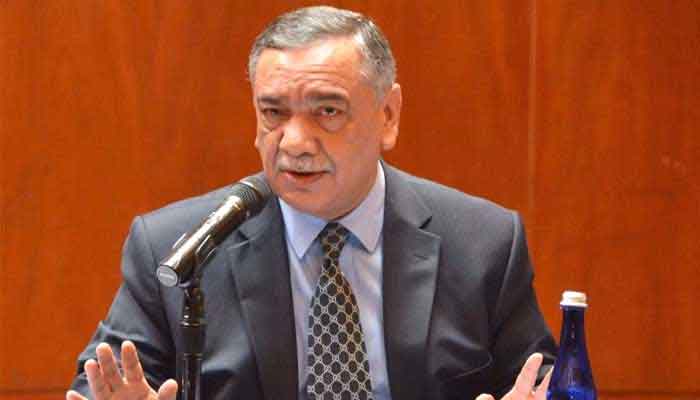A new chief justice
Once the SC assumes the mantle of fixing everyone and everything, what suffers most is its ability to undertake self-accountability and self-reform.
“Every new chief justice is greeted with the hope that he might attend to the most urgent challenge facing this country: a broken justice system.”
This I had written when Justice Saqib Nisar’s notification as CJP was issued in 2016. Under his watch, the Supreme Court was insatiable but the justice system remained as is. The challenges for the new CJP have thus increased. Justice Asif Saeed Khosa swears oath as CJP next week. The central question remains whether he will use the unbridled powers of his office to put the house in order.
We need a strong SC. But what kind of power and strength will the SC project when CJP Khosa leaves? Will it be power judged only by a personal sense of equity? Or will it be strength of the sort enjoyed by a court of law that creates legal certainty by dispensing justice as guided by the law, enjoys the reputation of being a neutral arbiter of law unscathed by partisan controversy and is cognizant of being a creature of the law with limited powers?
CJP Khosa will need to revisit the SC’s ethos to determine if they conform to the Code of Conduct for Judges. Article II of the code states that, “while dispensing justice, [a judge] should be strong without being rough, polite without being weak…” The SC mustn’t be a place where citizens fear to tread, worried about losing personal dignity due to remarks passed in court, or where proceedings are conducted such that leave no room for advocacy. Khyber Pakhtunkhwa, Sindh and Balochistan are not known for judicial discourtesy. Punjab is different. The apex court must not take after it.
Article V of the code states that, “functioning as he does in full view of the public, a judge gets thereby all the publicity that is good for him. He should not seek more. In particular he should not engage in any public controversy, least of all on a political question, notwithstanding that it involves a question of law.” At present, we have a system where trials in court and in the media run concurrently. This odious culture wherein tickers present SC proceedings as a sporting event and judges’ remarks become breaking news must end.
We seem to have reached a new normal. Media coverage of the CJP’s words and actions eclipses almost everything else nowadays. The apex court, especially in suo-motu cases, conducts itself such that proceedings and their media reporting (and not just written decisions) produce consequences. The contempt law is also brandished frequently to control speech critical of the court’s actions and to manage the public controversies that the court walks into. CJP Khosa and the SC will need to consider if this model is desirable and sustainable.
Article IX of the code states that, “disagreement with the opinion of any judge, whether of equal or of inferior status, should invariably be expressed in terms of courtesy and restraint.” In recent times, strictures haven’t been reserved for lawyers and litigants but have scathed judges too. In one unfortunate incident, a district court judge was made a spectacle of in full gaze of the media. We have also seen Article 184(3) proceedings conducted in relation to matters pending before high courts, thereby reducing their relevance as constitutional courts.
To be ‘sober as a judge’ is an old simile (the opposite is to be ‘drunk as a lord’). In terms of etymology, judges had jobs that required them to be composed, patient and wise, and were compared to nobles and princes who enjoyed power and pelf but weren’t required to be staid and clear-headed. Poet Charles Baudelaire had encouraged everyone to be drunk always. “On what? Wine, poetry or virtue as you wish,” he had said. But even he would probably make an exception for judges. A judge, even if drunk on virtue, would be too self-righteous to be sober.
The flight of temperance has often been seen in judicial proceedings since CJP Iftikhar Chaudhry made Article 184(3) the instrument of judicial hyper-activism. The jurisdiction vested in the SC under Article 184(3) is an institutional power that has unfortunately come to be regarded as the handmaid of an incumbent CJP. This power is completely unregulated. There are no intelligible criteria laid down for how it is to be exercised and what its limits are. Under the present CJP, the horizons of 184(3) have been expanded beyond previously conceivable limits.
In his speech inaugurating the new judicial year, CJP Saqib Nisar had announced publicly that the SC would soon determine the contours of 184(3). Despite much reliance on it since, no bench was constituted to structure and regulate its rampant use. The conflict inherent in such exercise is obvious. Any CJP who spells the limits of 184(3) and transforms it into what it is (ie an institutional power) would in effect be placing curbs on the unfettered power and discretion that he enjoys at the time by virtue of his office. But necessary it is to inject sobriety into the SC’s proceedings and certainty into judicial outcomes.
There are three models available to a new CJP: business-as-usual; cathartic-saviour; and judicial-reform. In the first, an incumbent see nothing wrong with how things are, enjoys his days in glory without seeking more and walks into the sunset. In the second, the incumbent wishes to build a legacy, save the nation, do good – but without being constrained by laws, principles and precedents when they get in the way of such righteous mission.
The cathartic-saviour model is often rationalised in the name of necessity or on the basis of the vacuum theory ie nature abhors a vacuum and if the executive and legislature don’t measure up, the judiciary must step in. That if the SC uses its pulpit to flag critical issues and then prods the executive to do something about it, it is only helping the executive discharge its duties. Built within this argument is a presumption that there is something unique about our DNA or state of existence as a polity that makes such intervention helpful if not necessary.
What this argument disregards is that usurping the role of another branch creates institutional imbalances and the short-circuit solution that the judiciary offers retards the long-term ability of the executive to discharge its functions. That the judiciary isn’t qualified, legally or practically, to step into the executive’s shoes and force its hand to make policy choices one way or another. It is only qualified to declare retrospectively that the executive has acted such that falls foul of the law, which is what judicial review is about.
Once the SC assumes the mantle of fixing everyone and everything, what suffers most is its ability to undertake self-accountability and self-reform. In this sense, the cathartic-saviour model is the antithesis of the judicial-reform model. Exposing executive failure and stepping into direct exercise of executive authority without worrying about unintended consequences amidst populist applause makes the cathartic-saviour model all-appealing. But it drives focus away from justice sector reform, which falls squarely within the judiciary’s province.
Isn’t it ironic that those who justify the SC’s activism, excessive use of 184(3) and overbearing intervention in the executive’s domain due to the executive’s failure to do what it is required to are the same folk who also justify the existence of military courts due to the judiciary’s failure to do what it is supposed to?
There were high hopes when CJP Nisar assumed office two years back. What became of them? We will be able to analyse next week once he hangs his robes. Will Justice Khosa continue on the primrose path his predecessor opted for or break free from the cathartic-saviour model?
Here is a New Year wish: may CJP Khosa take up the challenge of striding down the uncharted judicial-reform path instead.
The writer is a lawyer based in Islamabad.
Email: sattar@post.harvard.edu
-
 Rihanna To Announce Music Comeback And UK Stadium Shows
Rihanna To Announce Music Comeback And UK Stadium Shows -
 Tish Cyrus Calls Post-divorce Period 'roughest' Time Of Her Life
Tish Cyrus Calls Post-divorce Period 'roughest' Time Of Her Life -
 Prince Harry Turns To Hands-on Fatherhood As ‘crippling Social Anxiety’ Get Choke Hold
Prince Harry Turns To Hands-on Fatherhood As ‘crippling Social Anxiety’ Get Choke Hold -
 Pete Davidson Launches Talk Show From His Garage
Pete Davidson Launches Talk Show From His Garage -
 US To Suspend Immigrant Visa Processing For 75 Countries: Know All Details
US To Suspend Immigrant Visa Processing For 75 Countries: Know All Details -
 Ariana Madix And Tom Sandoval Settle Legal Dispute
Ariana Madix And Tom Sandoval Settle Legal Dispute -
 Travis, Jason Kelce React To Mom Donna's 'Traitors' Stint
Travis, Jason Kelce React To Mom Donna's 'Traitors' Stint -
 Justin Baldoni Says He Held A Prayer Gathering Before Deposition In Blake Lively Case
Justin Baldoni Says He Held A Prayer Gathering Before Deposition In Blake Lively Case -
 Enjoy Lee, Takaichi’s Viral Jamming Session, In Case You Missed It
Enjoy Lee, Takaichi’s Viral Jamming Session, In Case You Missed It -
 MrBeast Admits He's Unsure About Having Kids - Here's Why
MrBeast Admits He's Unsure About Having Kids - Here's Why -
 Prince Harry Carries Heartbreaking Hope For Archie, Lilibet Who Are Not Sharing In Their Royal Heritage
Prince Harry Carries Heartbreaking Hope For Archie, Lilibet Who Are Not Sharing In Their Royal Heritage -
 Tom Brady Breaks Silence On 'personal Life' After Alix Earle Rumors
Tom Brady Breaks Silence On 'personal Life' After Alix Earle Rumors -
 Guy Fieri Drops Health Update After Accident That Left Him In A Wheelchair
Guy Fieri Drops Health Update After Accident That Left Him In A Wheelchair -
 Experts Weigh In: Is Prince Harry Operating A PR Stunt Or The Invictus Games’
Experts Weigh In: Is Prince Harry Operating A PR Stunt Or The Invictus Games’ -
 Inside Kate Middleton’s Biography With Secrets From St Andrews To Harry & Meghan’s Royal Exit
Inside Kate Middleton’s Biography With Secrets From St Andrews To Harry & Meghan’s Royal Exit -
 Paul Mescal Reveals Shocking Move He Made In 'Hamnet'
Paul Mescal Reveals Shocking Move He Made In 'Hamnet'




